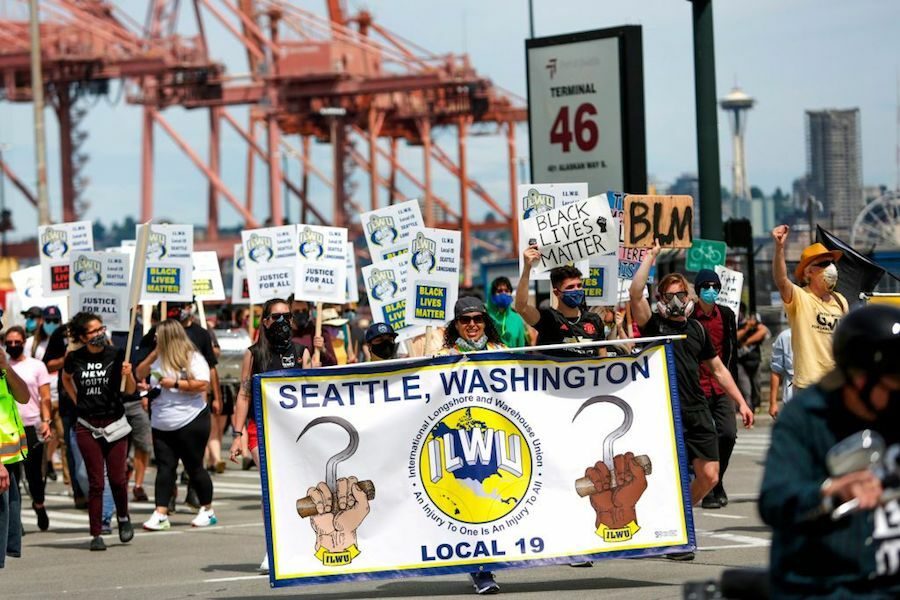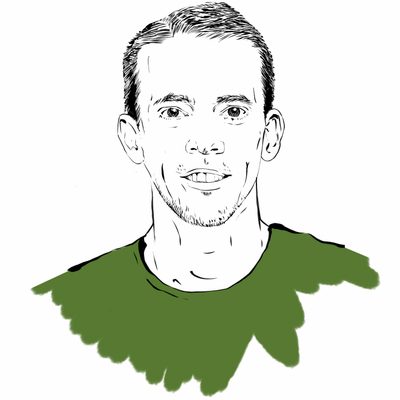
In work stoppages, rallies, motorcades and a spectacular West Coast port shutdown, labor tied itself to the movement in the streets.
BROOKLYN, N.Y. — The enormous white stone arch in Brooklyn’s Grand Army Plaza is a memorial to the Union’s victory in the Civil War. Confederate monuments are toppling across the country, but the arch is only getting more popular. At 11:30 on a hot Juneteenth morning, Kyle Bragg stands in its shade, wearing a red T-shirt, a New York Knicks-branded face mask, and a purple hat with the logo of 32BJ SEIU, the 175,000-member union that he leads.
“My son is 25, and my daughter is 29. I worry every single time they’re out of the house,” says Bragg, a Black man who has spent decades as a labor leader. “The most important conversation I had with them when they were young was not about sex or drugs. It was about how to deal with the police.”
The uprisings that have swept America this month are spontaneous, massive and often leaderless, and the structured world of unions initially seemed puzzled as to how to react. The burning of the AFL-CIO’s headquarters in the early days of the protests was symbolic of the disconnect between organized labor and the streets. But as the days went by, labor rallied to the cause. In the week leading up to Juneteeth, the June 19 holiday commemorating the end of slavery, it seemed unions found their voice.
The ILWU, the longshoremen’s union, spectacularly shut down West Coast ports on Juneteenth. United Auto Workers nationwide stopped work for eight minutes and 46 seconds in honor of George Floyd. The AFL-CIO’s headquarters, boarded up but newly festooned with “Black Lives Matter” banners, became a staging ground for marches and rallies. The labor federation organized a set of coordinated “Workers First Caravan” events across the country on Wednesday, June 17, with union members driving around in cars covered in signs demanding racial and economic justice.
It was not quite the socialist dream of melding labor’s class war with the movement for racial justice into one big, huge, perfect revolution, but it was something. It was an effort by organized labor to publicly tie its fate to that of the people marching in the streets, many of whom have no connection to unions. It was a start.
And in New York City, 32BJ — a union whose purple shirts and hats and banners are familiar to anyone who has been to any protest for economic justice in the city in the past decade — held protests for the entire week. On Tuesday, union members took a collective knee near Rockefeller Center, in honor of the 30th anniversary of SEIU’s “Justice for Janitors” strike in which Los Angeles police infamously beat and injured workers. And on Friday, Juneteenth itself, 32BJ gathered in Brooklyn for a motorcade that would wind through the city, all the way up to the Bronx, a purple river flowing through a landscape of anti-racism rallies citywide.
The pre-motorcade rally began just before noon at the Grand Army Plaza arch. Three children were assigned to hold up a green banner reading “JUNETEENTH DRIVE TO JUSTICE,” which kept drooping in the middle as the kids’ attention strayed. Assorted local officials had shown up to pay homage to the day, and to the union, and to the assembled media. The twist-the-knife ethos of New York City politics has been heightened by the weeks of uprisings, and the politicians who consider themselves the philosophical brethren of the protesters are enjoying their sudden moment of advantage against the entrenched powers. Jumaane Williams, the public advocate, gave an obligatory nod to the city’s new ban on police chokeholds, but made a point of not crediting city leaders.
“The only reason that’s happening is because the streets have been hot,” he said. “I know the governor said you won and you don’t have to protest any more. Nothing could be further from the truth!”
When 32BJ president Kyle Bragg’s turn came at the podium, he pulled his Knicks mask down to his chin. “It’s our mission to provide economic justice — but there is no economic justice without social justice,” he said. “There’s a triple threat. There’s an economic crisis. There’s a pandemic. And now there’s a racial crisis.”
As he was speaking, the microphone abruptly cut off; despite frantic effort, it could not be revived. All fell silent. But after a moment, someone handed Bragg a megaphone. He held it up to his mouth, and carried on.
Hamilton Nolan is a labor writer for In These Times. He has spent the past decade writing about labor and politics for Gawker, Splinter, The Guardian, and elsewhere. More of his work is on Substack.








